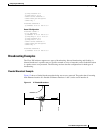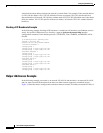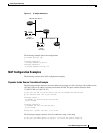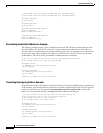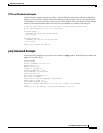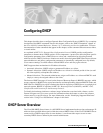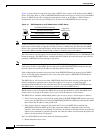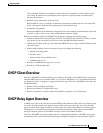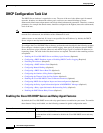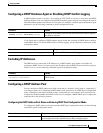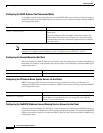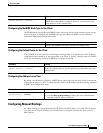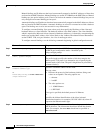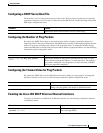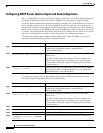
Configuring DHCP
DHCP Client Overview
IPC-67
Cisco IOS IP Configuration Guide
Using automatic IP address assignment at each remote site substantially reduces Internet access
costs. Static IP addresses are considerably more expensive to purchase than are automatically
allocated IP addresses.
• Reduced client configuration tasks and costs
Because DHCP is easy to configure, it minimizes operational overhead and costs associated with
device configuration tasks and eases deployment by nontechnical users.
• Centralized management
Because the DHCP Server maintains configurations for several subnets, an administrator only needs
to update a single, central server when configuration parameters change.
Before you configure the Cisco IOS DHCP Server feature, complete the following tasks:
• Identify an external File Transport Protocol (FTP), Trivial File Transfer Protocol (TFTP), or remote
copy protocol (rcp) server that you will use to store the DHCP bindings database.
• Identify the IP addresses that you will enable the DHCP Server to assign, and the IP addresses that
you will exclude.
• Identify DHCP options for devices where necessary, including the following:
–
Default boot image name
–
Default routers
–
Domain Name System (DNS) servers
–
NetBIOS name server
• Decide on a NetBIOS node type (b, p, m, or h).
• Decide on a DNS domain name.
DHCP Client Overview
The Cisco IOS DHCP client now enables you to obtain an IP address from a DHCP Server dynamically
using the DHCP protocol as specified in RFC 2131. In Cisco IOS Release 12.2, only Ethernet interfaces
are supported; work is in progress to support all interface types. The Cisco IOS DHCP client offers the
following benefits:
• Reduces time to configure and deploy
• Reduces the number of configuration errors
• Enables customers to centrally control the IP address assigned to a Cisco IOS router
DHCP Relay Agent Overview
A DHCP relay agent is any host that forwards DHCP packets between clients and servers. Relay agents
are used to forward requests and replies between clients and servers when they are not on the same
physical subnet. Relay agent forwarding is distinct from the normal forwarding of an IP router, where
IP datagrams are switched between networks somewhat transparently. Relay agents receive DHCP
messages and then generate a new DHCP message to send out on another interface.
The Cisco IOS DHCP relay agent supports the use of unnumbered interfaces. The DHCP relay agent
automatically adds a static host route specifying the unnumbered interface as the outbound interface.



